Module 5 Shopping Unit 3 Language in use课件(外研版英语七年级下册)
文档属性
| 名称 | Module 5 Shopping Unit 3 Language in use课件(外研版英语七年级下册) | 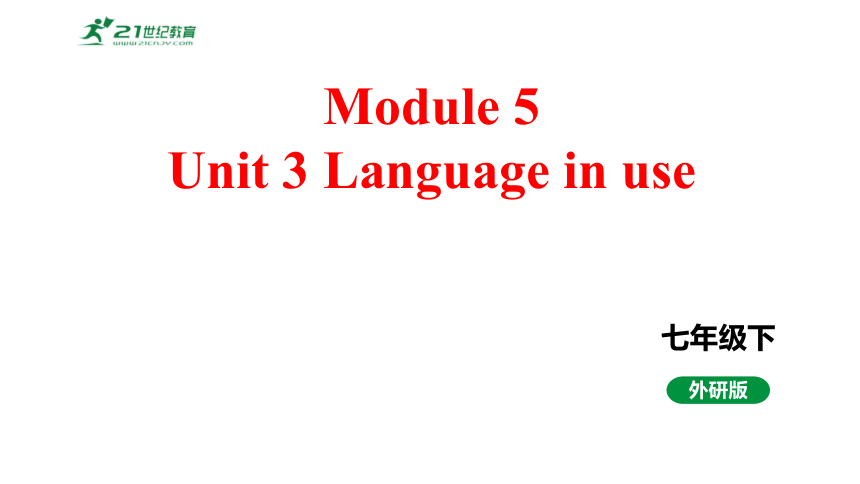 | |
| 格式 | pptx | ||
| 文件大小 | 5.5MB | ||
| 资源类型 | 试卷 | ||
| 版本资源 | 外研版 | ||
| 科目 | 英语 | ||
| 更新时间 | 2024-02-27 16:33:08 | ||
图片预览

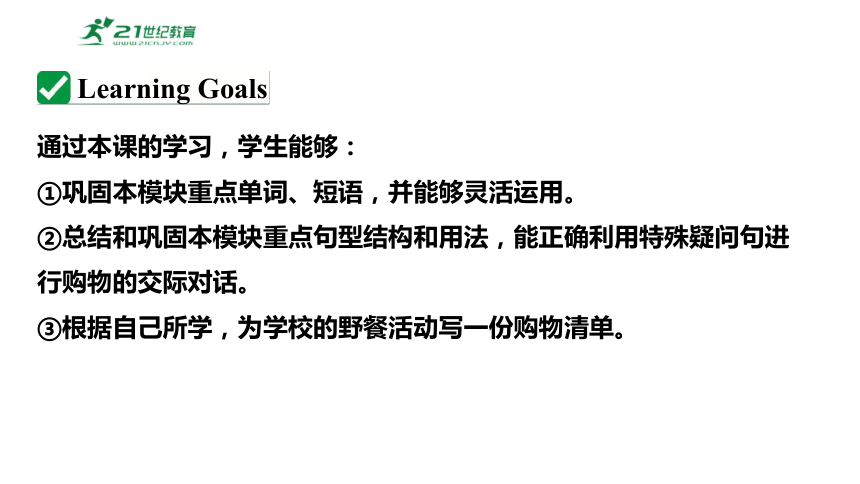


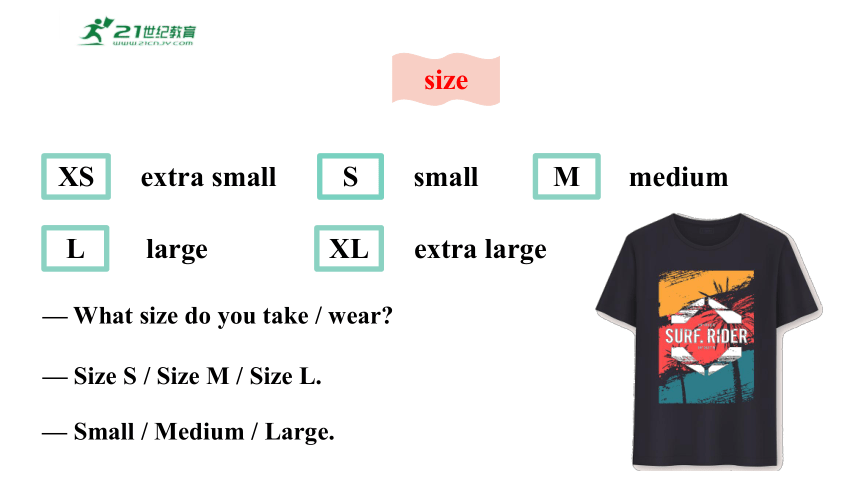
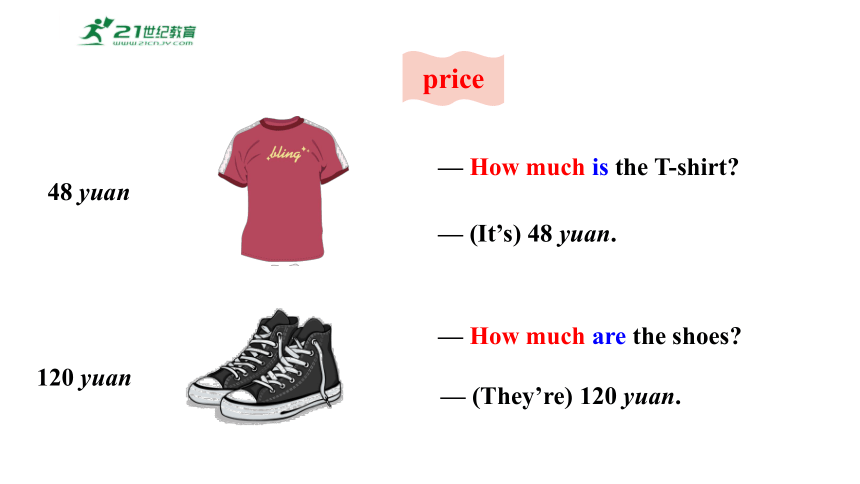
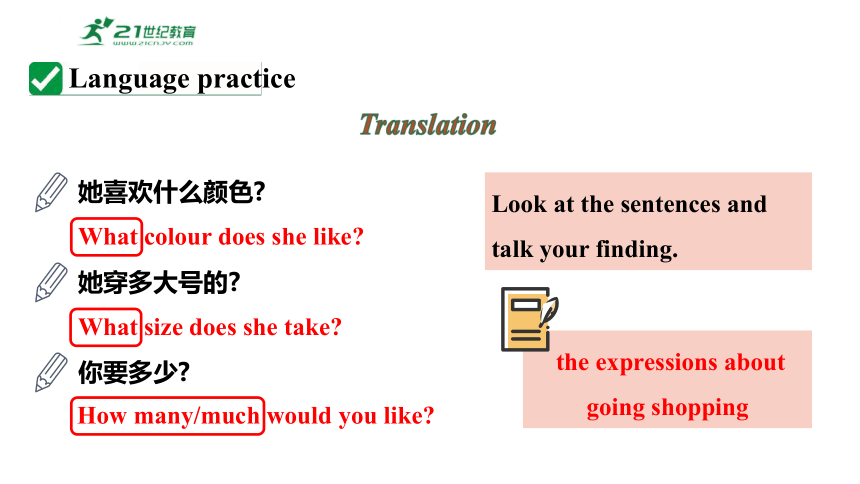
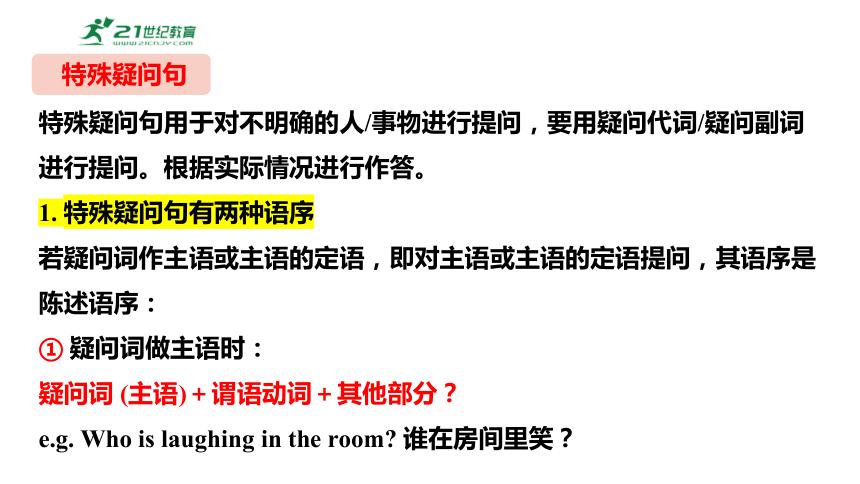
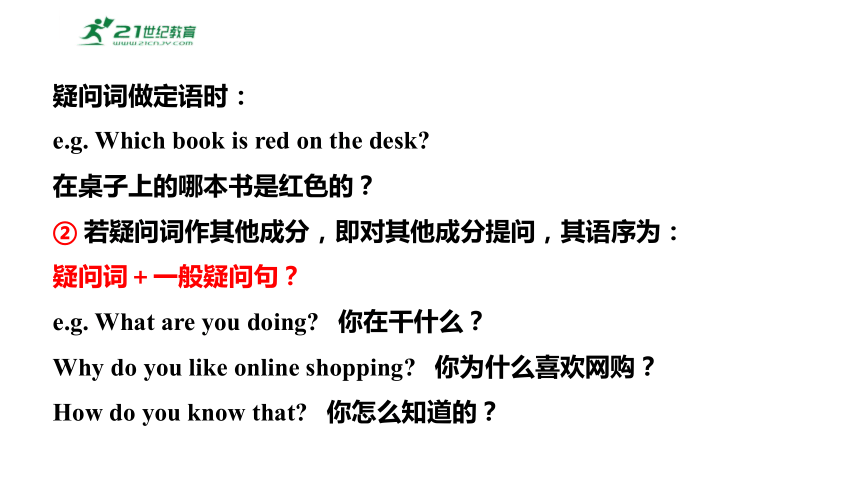
文档简介
(共23张PPT)
Module 5
Unit 3 Language in use
七年级下
外研版
Learning Goals
通过本课的学习,学生能够:
①巩固本模块重点单词、短语,并能够灵活运用。
②总结和巩固本模块重点句型结构和用法,能正确利用特殊疑问句进行购物的交际对话。
③根据自己所学,为学校的野餐活动写一份购物清单。
Warming Up
What do we talk about when we buy clothes
color
size
price
— What colour do you like
— Yellow / Green.
colour
M
L
S
small
medium
large
XS
extra small
XL
extra large
size
— What size do you take / wear
— Size S / Size M / Size L.
— Small / Medium / Large.
price
— How much is the T-shirt
— (It’s) 48 yuan.
48 yuan
— How much are the shoes
— (They’re) 120 yuan.
120 yuan
Language practice
Translation
她喜欢什么颜色
她穿多大号的
你要多少
What colour does she like
What size does she take
How many/much would you like
Look at the sentences and talk your finding.
the expressions about going shopping
特殊疑问句用于对不明确的人/事物进行提问,要用疑问代词/疑问副词进行提问。根据实际情况进行作答。
1. 特殊疑问句有两种语序
若疑问词作主语或主语的定语,即对主语或主语的定语提问,其语序是陈述语序:
① 疑问词做主语时:
疑问词 (主语)+谓语动词+其他部分?
e.g. Who is laughing in the room 谁在房间里笑?
特殊疑问句
疑问词做定语时:
e.g. Which book is red on the desk
在桌子上的哪本书是红色的?
② 若疑问词作其他成分,即对其他成分提问,其语序为:
疑问词+一般疑问句?
e.g. What are you doing 你在干什么?
Why do you like online shopping 你为什么喜欢网购?
How do you know that 你怎么知道的?
2. 特殊疑问词的用法
(1) 常见的疑问代词有:
who 谁
e.g. Who is the girl in red 那个穿红色衣服的女孩是谁?
whom 对人进行提问,用作介词或动词的宾语。
e.g. Whom did they invite 他们邀请谁了?
whose 谁的,询问某物的归属。
e.g. I wonder whose this is. 我不知道这是谁的。
what 什么,对事物进行提问。
e.g. What is your name 你叫什么名字?
which 哪一个,对多个选择进行提问。
e.g. Which is better exercise—swimming or tennis
游泳和网球,哪种运动比较好?
(2) 常见的疑问副词有:
when 什么时候
e.g. When can I see you 我什么时候可以见你?
where 在哪里
e.g. Where do you live 你住在哪儿?
why 为什么
e.g. Why were you late 你为什么迟到?
how 怎样,如何
e.g. How does it work 它运转得怎么样?
3. 常见的疑问词组有:
(1) what+名词
e.g. what colour/size/date/time/...
What colour are their hats
他们的帽子是什么颜色的?
What size do you take
你穿多大号的?
(2) how+形容词/副词
e.g. how old/many/much/far/often/long/soon ...
How old are you, my dear friend 亲爱的朋友,你几岁了?
I didn’t know how much to bring. 我不知道该带多少。
How often do you go swimming 你多久去游泳一次?
How long will the flight take 此次航班将飞行多长时间?
How long is the River Nile 尼罗河有多长?
1. Work in pairs. Look at the picture. Ask and answer.
what / size / take
—What size do you take
—Size S.
1 what / size / take
2 how much / eggs
3 how much / beef
4 what / colour / like
—What size do you take —Size M.
—How much are the eggs —10 yuan a kilo.
—How much is the beef —50 yuan a kilo.
—What colour do you like —Blue.
a) Half a kilo, please.
b) Twenty yuan a kilo.
c) Green.
d) Yes, please. I want some bananas.
e) Yes. Here you are.
f) Sixty-eight yuan.
g) I don’t like blue.
h) Large.
2. Match the sentences in Column A with the sentences in Column B.
1 Can I help you
2 How much are they
3 What size do you take
4 How much meat do you want
5 Can I try it on
6 How much is that T-shirt
7 What colour would you like
8 What about this one
d
b
h
a
e
f
c
g
3. Write down as many words as you can in each column.
How many How much
eggs milk
bananas, apples,
lemons, oranges,
strawberries,
sausages …
meat, beef,
pork, juice,
tea, rice …
4. Complete the sentences with how much or how many.
1. ___________ lemons would you like
2. ___________ kilos of sausages do you want
3. ___________ coffee do you want
4. ___________ boxes of strawberries do you want
5. ___________ meat shall I buy
6. ___________ milk have you got
How many
How many
How much
How many
How much
How much
Catalogue shopping
There are many ways of shopping in America today. One popular way is catalogue shopping. There are catalogues for almost anything you need—
like clothes, toys, computers, things to cook with and so on. A lot of people order their music and books from catalogues.
/ k t l ɡ /n. 目录;目录簿
Around the world
5. Work in pairs. Write a shopping list for a school picnic.
Writing a shopping list for a school picnic
· What food do you need
· What drinks do you need
· How much/many do you need
Module task
6. Work with other students and compare your lists.
· Find out more about their lists.
· Add more things to your list.
7. Present your shopping list to the class. Choose the best list.
1. Grammar:
①To summarise and consolidate expressions about going shopping.
②To revise new words and phrases.
③To write a shopping list for a school picnic.
2. Reading:
Catalogue shopping.
Summary
为你的家庭聚会制定一份购物清单,同时请运用“how many”和“how much”对所需物品的数量进行提问。
实践与拓展
Module 5
Unit 3 Language in use
七年级下
外研版
Learning Goals
通过本课的学习,学生能够:
①巩固本模块重点单词、短语,并能够灵活运用。
②总结和巩固本模块重点句型结构和用法,能正确利用特殊疑问句进行购物的交际对话。
③根据自己所学,为学校的野餐活动写一份购物清单。
Warming Up
What do we talk about when we buy clothes
color
size
price
— What colour do you like
— Yellow / Green.
colour
M
L
S
small
medium
large
XS
extra small
XL
extra large
size
— What size do you take / wear
— Size S / Size M / Size L.
— Small / Medium / Large.
price
— How much is the T-shirt
— (It’s) 48 yuan.
48 yuan
— How much are the shoes
— (They’re) 120 yuan.
120 yuan
Language practice
Translation
她喜欢什么颜色
她穿多大号的
你要多少
What colour does she like
What size does she take
How many/much would you like
Look at the sentences and talk your finding.
the expressions about going shopping
特殊疑问句用于对不明确的人/事物进行提问,要用疑问代词/疑问副词进行提问。根据实际情况进行作答。
1. 特殊疑问句有两种语序
若疑问词作主语或主语的定语,即对主语或主语的定语提问,其语序是陈述语序:
① 疑问词做主语时:
疑问词 (主语)+谓语动词+其他部分?
e.g. Who is laughing in the room 谁在房间里笑?
特殊疑问句
疑问词做定语时:
e.g. Which book is red on the desk
在桌子上的哪本书是红色的?
② 若疑问词作其他成分,即对其他成分提问,其语序为:
疑问词+一般疑问句?
e.g. What are you doing 你在干什么?
Why do you like online shopping 你为什么喜欢网购?
How do you know that 你怎么知道的?
2. 特殊疑问词的用法
(1) 常见的疑问代词有:
who 谁
e.g. Who is the girl in red 那个穿红色衣服的女孩是谁?
whom 对人进行提问,用作介词或动词的宾语。
e.g. Whom did they invite 他们邀请谁了?
whose 谁的,询问某物的归属。
e.g. I wonder whose this is. 我不知道这是谁的。
what 什么,对事物进行提问。
e.g. What is your name 你叫什么名字?
which 哪一个,对多个选择进行提问。
e.g. Which is better exercise—swimming or tennis
游泳和网球,哪种运动比较好?
(2) 常见的疑问副词有:
when 什么时候
e.g. When can I see you 我什么时候可以见你?
where 在哪里
e.g. Where do you live 你住在哪儿?
why 为什么
e.g. Why were you late 你为什么迟到?
how 怎样,如何
e.g. How does it work 它运转得怎么样?
3. 常见的疑问词组有:
(1) what+名词
e.g. what colour/size/date/time/...
What colour are their hats
他们的帽子是什么颜色的?
What size do you take
你穿多大号的?
(2) how+形容词/副词
e.g. how old/many/much/far/often/long/soon ...
How old are you, my dear friend 亲爱的朋友,你几岁了?
I didn’t know how much to bring. 我不知道该带多少。
How often do you go swimming 你多久去游泳一次?
How long will the flight take 此次航班将飞行多长时间?
How long is the River Nile 尼罗河有多长?
1. Work in pairs. Look at the picture. Ask and answer.
what / size / take
—What size do you take
—Size S.
1 what / size / take
2 how much / eggs
3 how much / beef
4 what / colour / like
—What size do you take —Size M.
—How much are the eggs —10 yuan a kilo.
—How much is the beef —50 yuan a kilo.
—What colour do you like —Blue.
a) Half a kilo, please.
b) Twenty yuan a kilo.
c) Green.
d) Yes, please. I want some bananas.
e) Yes. Here you are.
f) Sixty-eight yuan.
g) I don’t like blue.
h) Large.
2. Match the sentences in Column A with the sentences in Column B.
1 Can I help you
2 How much are they
3 What size do you take
4 How much meat do you want
5 Can I try it on
6 How much is that T-shirt
7 What colour would you like
8 What about this one
d
b
h
a
e
f
c
g
3. Write down as many words as you can in each column.
How many How much
eggs milk
bananas, apples,
lemons, oranges,
strawberries,
sausages …
meat, beef,
pork, juice,
tea, rice …
4. Complete the sentences with how much or how many.
1. ___________ lemons would you like
2. ___________ kilos of sausages do you want
3. ___________ coffee do you want
4. ___________ boxes of strawberries do you want
5. ___________ meat shall I buy
6. ___________ milk have you got
How many
How many
How much
How many
How much
How much
Catalogue shopping
There are many ways of shopping in America today. One popular way is catalogue shopping. There are catalogues for almost anything you need—
like clothes, toys, computers, things to cook with and so on. A lot of people order their music and books from catalogues.
/ k t l ɡ /n. 目录;目录簿
Around the world
5. Work in pairs. Write a shopping list for a school picnic.
Writing a shopping list for a school picnic
· What food do you need
· What drinks do you need
· How much/many do you need
Module task
6. Work with other students and compare your lists.
· Find out more about their lists.
· Add more things to your list.
7. Present your shopping list to the class. Choose the best list.
1. Grammar:
①To summarise and consolidate expressions about going shopping.
②To revise new words and phrases.
③To write a shopping list for a school picnic.
2. Reading:
Catalogue shopping.
Summary
为你的家庭聚会制定一份购物清单,同时请运用“how many”和“how much”对所需物品的数量进行提问。
实践与拓展
同课章节目录
- Module 1 Lost and found
- Unit 1 Whose bag is this?
- Unit 2 Are they yours?
- Unit 3 Language in use
- Module 2 What can you do ?
- Unit 1 I can play the piano
- Unit 2 I can run really fast
- Unit 3 Language in use
- Module 3 Making plans
- Unit 1 What are you going to do at the weekends?
- Unit 2 We're going to cheer the players.
- Unit 3 Language in use
- Module 4 Life in the future
- Unit 1 Everyone will study at home
- Unit 2 Every family will have a small plane.
- Unit 3 Language in use
- Module 5 Shopping
- Unit 1 What can I do for you?
- Unit 2 You can buy everything on the Internet
- Unit 3 Language in use
- Module 6 Around town
- Unit 1 Could you tell me how to get to the Nationa
- Unit 2 The London Eye is on your right.
- Unit 3 Language in use
- Revision module A
- Module 7 My past life
- Unit 1 I was born in a small village.
- Unit 2 I was born in Quincy.
- Unit 3 Language in use
- Module 8 Story time
- Unit 1 Once upon a time….
- Unit 2 Goldilocks hurried out of the house.
- Unit 3 Language in use
- Module 9 Life history
- Unit 1 He left school and began work at the age of
- Unit 2 He decided to be an actor.
- Unit 3 Language in use
- Module 10 A holiday journey
- Unit 1 What did you do?
- Unit 2 This morning we took a walk.
- Unit 3 Language in use
- Module 11 Body language
- Unit 1 They touch noses!
- Unit 2 Here are some ways to welcome them.
- Unit 3 Language in use
- Module 12 Western music
- Unit 1 It's so beautiful!
- Unit 2 Vienna is the centre of European classical
- Unit 3 Language in use
- Revision module B
